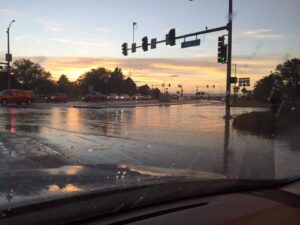
Grand Valley residents were hit this year with an additional $36 annual fee to help fund improvements within the Grand Valley Drainage District. But why, and why so out of the blue?
The fee came as a surprise to homeowners because the Drainage District sent notices of the fee only to business owners in an effort to try to save their already-scarce funds. The District regrets this now and they believe they should have done more outreach to residents about the fee, no matter the cost.
That said, many of the problems leading up to this extra fee being necessary are traceable to the actions of the Mesa County Commissioners.
Mesa County Let Developers Slide for Decades
Long time Mesa County residents are probably familiar with the County Commissioners’ reputation for bending over backwards to please land developers.
Over the last few decades, our commissioners frequently green-lighted new housing and retail developments that violated area land use plans, their own Planning Commission’s recommendations, and even the recommendations of the County’s paid staff of professional land use planners.
Maybe the Commissioners were trying to jump-start our area’s perpetually sagging economy, and maybe they were trying to curry favor with land-owning buddies wanting to cash in on developing their farmland, but whatever the reason, in the long run the Commissioners’ actions created cumulative problems which are now coming home to roost, and are costing the rest of us a pretty penny.
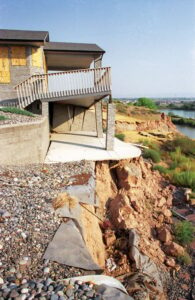
Mesa County is a statutory county and the Commissioners here serve in a “quasi-judicial capacity” over land use, which means they literally serve as judge and jury over land use decisions. Their decisions to approve or reject new housing and retail developments, and under what circumstances, are final. There is no recourse against their votes, no matter how thoughtless they are, leaving the Commissioners free to do whatever they want, whenever they want, land use plans be damned.
The Commissioners have made LOTS of bad land use decisions, too, over many, many years: They regularly let developers off the hook for drainage, setbacks, development and other fees; they let developers build in places they shouldn’t (like around the airport, too close to crumbling bluffs over the river and in areas with high water tables) and let them build projects that violated land use plans. Over the years, this slowly created a tremendous mess for the rest of us due to poorly constructed drainage and irrigation systems, inconsistent development, sub-par housing developments, “leapfrogged development” that led to higher utility fees, urban sprawl, crumbling subdivisions and other problems. The Commissioners even let developers build entire subdivisions that violated good planning requirements, leading to severe problems for homeowners like people who bought houses in the Valle Vista subdivision on Orchard Mesa, where developers stuck homeowners with a non-functioning open sewage lagoon in their own neighborhood.
Now the County Commissioners have passed the buck to the rest of us to clean up their mess, and the cost right now is the $36 a year additional
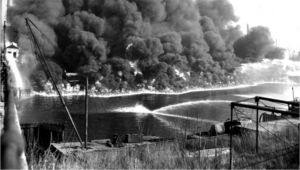
drainage district fee for residents.
What You Need to Know
The U.S. Environmental Protection Agency (EPA) started regulating stormwater runoff In 1972, when the Clean Water Act went into effect. The EPA defines “stormwater” as any water that hits an impervious surface like a parking lot, roof, street or highway, and then runs off it. Stormwater picks up oil, grease, chemicals, grit and dirt which then gets dumped back into the rivers, polluting the waterways. In the late 1960s and early 1970s, the U.S. had a terrible problem with rivers being polluted with industrial waste, to the point that rivers were literally catching on fire.
The Clean Water Act was put in place to address that problem.
At the time the Clean Water Act went into effect in 1972, most of the Grand Valley was farmland. Rain and snow fell on bare land and just soaked into the ground, and the G.V. Drainage District mostly just had to regulate agricultural seep and make sure leftover irrigation water got returned to the river. But as more people moved here and the commissioners started approving more and more housing developments, big box stores, parking lots and new streets with little consideration of good planning and future needs, the amount of impervious surfaces increased, and we were left with more stormwater runoff to deal with than ever before.
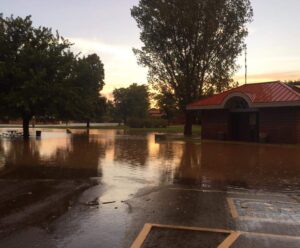
The Grand Valley Drainage District was charged with dealing with that stormwater, but had no say over the Commissioners’ land use decisions. The Drainage District was the agency that got left holding the bag when the commissioners waived drainage fees and let developers build improper drainage time and again.
The County was supposed to charge developers drainages fees all along, and if they had done that, it would have helped the Drainage District keep up with development, but the County didn’t. The Commissioners also approved housing projects that drained stormwater water back into irrigation lines — a real no-no — instead of draining it into properly constructed drainage systems.
Playing fast and loose with development this way for so long has led to big trouble.
It’s not like the Commissioners were unaware of the problems they were creating, either.
In just one example, an October, 2006 Mesa County Utilities report in the Clifton-Fruitvale Community Plan of 2006 states,
“The current [drainage] system is inadequate and is getting worse with urbanization. There are not many facilities to collect and transmit stormwater…”
The report also points to the very problem the Grand Valley Drainage District is facing today:
“Drainage Key Issues: Lack of adequate stormwater drainage facilities to handle urban development…”
The County Commissioners could have done their jobs much better and kept the long term well-being of our area in mind when making land use decisions, but they didn’t, and now we’re all paying the price.
The Grand Junction Area Chamber of Commerce is Suing the Drainage District?!? What’s THAT about?
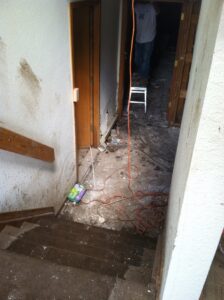
The Grand Junction Area Chamber of Commerce, which often acts more like a conservative lobbying group than a normal chamber of commerce, hates anything it thinks is a “tax,” and it thinks lots of things are taxes that are not.
The chamber mistakenly thinks the new Drainage District fee is a tax. But it is a fee, not a tax, and the law permits the Drainage District to charge fees.
The chamber lacks an understanding of the difference between a fee and a tax.
What is the difference?
Taxes are levied primarily to raise revenue, but a fee is charged to recoup the cost of providing a service. The Drainage District provides the service of stormwater drainage to area residents, and they need to adequately fund that mandate in order to protect all of us from flooding.
The chamber thinks the extra drainage fee being charged to businesses is way too high, but the fact is that businesses are being charged the fee at exactly the same rate as residents. The new fees are based on the total square footage of impervious surface on a given property. Businesses are usually bigger than homes and have more roof space and more parking lots (e.g., more impervious surfaces) than houses do, so businesses must pay higher fees. Think WalMart, Sam’s Club and other big box stores. Their buildings are way bigger than houses, and they have huge, paved parking lots that contribute far more stormwater runoff to the drainage system. Businesses simply burden the drainage system more than houses, and have to pay to offset that proportional burden.
So the Drainage District is treating businesses exactly the same as the rest of us. They’re just asking businesses to pay their part.
It’s actually a very even-handed approach, but when the chamber complained that the fees for business were too high, the G.V. Drainage District was open to working with the chamber to come up with a solution. The District asked the chamber to suggest some other ways to charge businesses. The chamber pointed to a tiered fee system currently in use on the front range, but when the District explored how that system worked, they found businesses on the front range were paying more under the tiered system than they would under the system where the fees charged to businesses are the same as are charged to homeowners. So the Drainage District asked the chamber to propose something else.
The chamber never answered.
Instead, the chamber turned filed a lawsuit against the Drainage District to try and block the fee completely by insisting that it is a tax. Then Mesa County joined the chamber’s lawsuit and both entities ganged up on the Drainage District.
Mesa County is suing the Drainage District? Over problems the County itself helped create?
Yup, that’s right.
Now, think about this for a minute:
The County that waived drainage fees right and left for developers for decades is suing the G.V. Drainage District for levying a fee to deal with the problems the County created by failing to charge drainage fees.
So the County is suing the Drainage District over problems the County itself created.
It sounds crazy, and that’s because it is.
Talk about a blame game.
We have an unaccountable county, and a chamber of commerce that doesn’t understand the difference between a fee and a tax, and now area taxpayers not only have to pay for drainage improvements, but for the county’s lawsuit as well.
It’s appalling and stupid as all get out, and points to how many bad decisions the Mesa County Commissioners have made for so long, and the bad decisions they continue to make, at all of our expense.
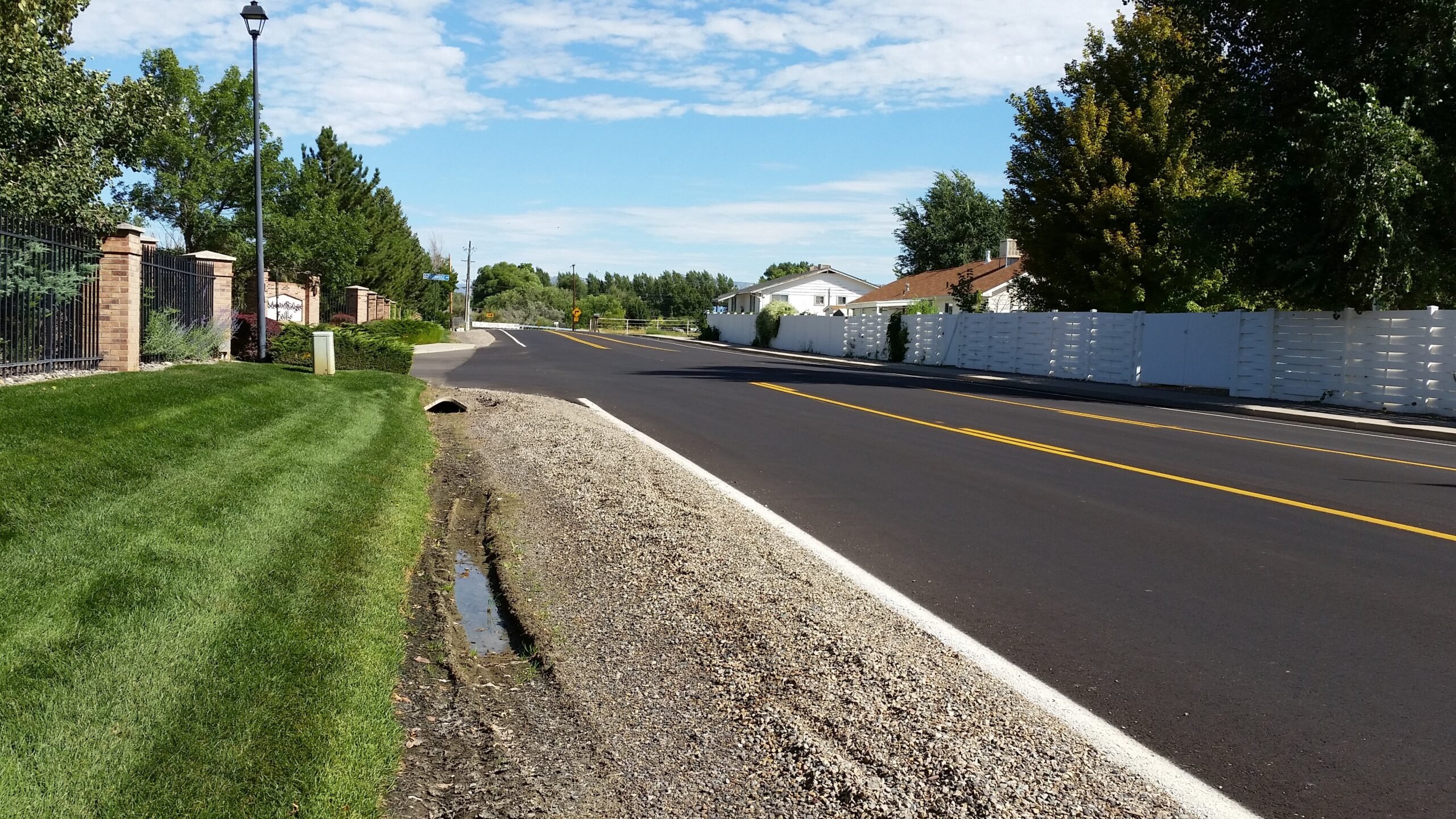
Even worse for the chamber and the County, a District court ruled on July 19, 2016 that the Drainage District’s fee is in fact a legitimate fee and not a tax. But the chamber and County are going to appeal that ruling, so taxpayers and chamber members will keep on paying for this pointless and counterproductive lawsuit into the future. The County is also now blaming the leadership of the Drainage District for doing what it has to do to carry out its mission, as if changing the District’s leadership will fix all the problems they’ve created.
Why Should We Care About Drainage Anyway?
Streets, bridges, power lines, schools, libraries, and treated domestic water systems are examples of publicly-funded infrastructure systems. We see and use these systems every day and appreciate what they do for us. Sewer and drainage systems are a bit different, though — they are buried, invisible and less used, but no less important. Few people pay attention to sewers or drainage until it goes wrong, or until they really need it, and usually they only pay attention to drainage systems when they don’t work right. No one thinks about stormwater runoff until their own basement gets flooded. Then all of a sudden people get really, really interested.
This trick is to make sure these systems are adequately built, in place and functioning correctly before you ever need them.
So how do you get people excited about something they can’t see, and that isn’t used until times get desperate?
You probably can’t. And the Mesa Commissioners, who were even paid to take an interest in the adequacy of our area’s drainage systems weren’t interested in them, either.
So Let’s Learn the Lesson Before Disaster Hits
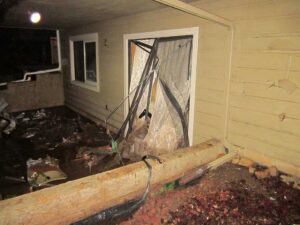
In September, 2013, Boulder County, Colorado was deluged with 17 inches of rain in just two days. The results were catastrophic. People lost their lives, and the property loss was staggering. Agriculture suffered, too. It’s taken years to recover, and many people still have not recovered, and never will.
Recently it’s been becoming increasingly common for localities to get a year’s worth of rain in a day or two. In June of 2016, West Virginia got 10 inches of rain in a single day. Just recently, Baton Rouge, Louisiana got two feet of rain in 48 hours. In such tragedies, an adequately-designed, properly-functioning drainage system is crucial. It can help save lives, as well as hundreds of thousands, even millions of dollars in property damage. The problem is, proper drainage systems must be built well in advance of disasters for them to be effective, not after.
If you’ve ever had a brush with a real flood and seen and felt the consequences, you’ll never forget the value of a good drainage system.
$36 per 2,500 square feet of impervious surface is a cheap compared to flood insurance or hundreds of thousands of dollars in property damage from a rain catastrophe like the one that hit Boulder in 2013, and these other places. The Grand Valley is not immune to such events. We’ve already had our share of flooding, enough to make us sit up, take notice, and start preparing for the day when we have to deal with an extreme rain deluge.
So go ahead and pay the Drainage District’s new fee. Do it willingly, and be glad we have a Drainage District that’s looking out for us, even if the Mesa County Commissioners and the Grand Junction Area Chamber aren’t, never have and likely never will.

I would disagree that this is a fee. A fee is where a Citizen can choose to pay. An example would be paying “fees” for delivering electric and water to my home. However, if I choose to not pay those fees I could use candles and flashlights or buy bottled water from a local store … essentially the point is I am not mandated to purchase those services and pay the fee.
The Grand Valley Drainage District is a “Mandated Tax” because the Citizens were not given a choice on whether to pay! It was shoved down throats as a MUST pay Tax or face consequences. While I could agree the County holds some fault by not having Developers pay appropriate past fees … the Drainage District had no right to force a mandated tax on the people without their proper consent. Again, I can choose to pay fees … Where was my choice in this instance?
Janet, the Grand Valley Drainage District will waive the $36 annual fee for people who can demonstrate financial hardship. The policy on what is required to obtain a waiver is here: http://thedrainagedistrict.org/wp-content/uploads/2017/08/2015-109-Hardship.pdf (pdf). The mill levy tax the GVDD collects from the county must be used for seep and irrigation return flows, but cannot be used for urban stormwater management. The county must be able to manage the quantity and quality of it’s urban stormwater runoff or face stopping development until it’s capacity to manage such runoff increases to meet the needs. GVDD’s resolution about the fee says it came about as the result of “a decades-long community-wide failure to require each new development to pay it’s fair share of the cost of providing adequate storm drainage facilities.” In short, the commissioners have waived drainage requirements for far too many developers, and now we all have to pay the price. If people have a problem with the GVDD’s stormwater fee, they needs to address the Board of County Commissioners (BOCC) because they approve any an all development and waivers of drainage requirements, so basically this whole mess is their fault.
The Grand Valley Drainage District is a Division of ALL the Local Governments not just the County. You cannot blame just one government entity for the fault of all of them in not properly managing. It is funded by them all along with the property tax mill levy. That is why their so called “fee” will most likely be deemed a Tax.
The CO Supreme Court ruled on the City of Aspen bag fee today. Per that ruling a fee to benefit a government entity is potentially a tax. I am contending the Drainage District is subject to Tabor … the way they implemented their “fee” was wrong.
The verdict is in … Grand Valley Drainage District lost the lawsuit. Their so called “fee” is considered a tax. They should have properly asked the voters for an increase vs trying to “double dip” into people’s pockets.
Please explain “double dip” Janet.
Citizens were already paying via their mill levy on property tax bill … then paying again via the fee that GVDD was charging. Essentially GVDD receiving money twice for their service provided.
The operating costs stayed static and are what is levied on property tax. But when government or business entities decide a “capital” design is required and it takes more then a decade to acquire the funds, when the money comes it has to be used or in the case of the drainage district, they have no funds for capital projects.
The Drainage district may have taken the wrong path on the fee. But that still DOES NOT preclude the need for drainage updates. The last increase to that levy was decades ago. Costs go up. If there was any cushion there is none now. So to characterize them as “double dipping” is harsh. This valley is going to feel the brunt of this drought. The efficacy of drainage in this valley could have a profound influence if one area over another have access to water. The district is compromised, which puts all of us on ditches, that use ditch water, that drink from the Colorado, at a safety deficit. Anyone that has lived here for a time has seen the effects of a downpour during a drought.
I see your point Janet. But “fees” are not something a citizen “chooses” to pay. A fee is a payment, by definition, to a “professional entity” whether it be a person or professional entity. The Drainage dist. is a professional entity. If they have no money for capital expenses they can make no improvements.
If the voters in this county could understand the value of investing in improving roads, schools, drainage, the 911 system, or any other professional service, and then ACTUALLY VOTE that investment into place on a regular basis, we could stop playing catch-up. There is the old adage…”A stitch in time saves nine.” I would rather pay a small “required” fee on a monthly basis, then to pay for massive damage to the infrastructure directly and via my insurance costs for decades to come.
There are new technologies for drainage that preserve water volumes. As this valley dries up, and it is, the issue of water access will becomes a tangible priority for everyone, even those who do not wish to pay their share of community improvements. Think about it for your progeny. They will have to live with our selfish miscalculations.
I would respectfully disagree … a “fee” is voluntary payment for a service provided. For example I agree to pay “fees” to my electric, gas, trash, water, etc. service providers because I am purchasing a service which they provide. I also must “request” their service in order for them to charge their “fees”. And they are not funded via any of my taxes already paid via mill levy.
The Grand Valley Drainage District is not in the same realm because they are not a professional entity … they are a government entity. They are a division of all the local governments. And as such they are funded via our property tax mill levy. Their own website states:
“The Grand Valley Drainage District is a Special District that is a division of local government. Formed on September 7, 1915, the district is responsible for safely returning ground water, irrigation water and storm water to the Colorado River.”
I sit on around 6 acres and they charged a “fee” in addition to our mill levy for something they do not provide my family. I don’t have run off … any irrigation and rain soaks into the land. Also, I have one of main canals through my property along with a natural wash … and per their “fee” resolution they noted that they do not control or monitor “natural washes”. So the question then becomes … why am I even charged a mill levy for our property??? Which I have not questioned until now.
If the Valley as you have noted is “drying up” … then why are we looking at expanding storm drainage? Less moisture would mean less drainage needed.
But you see that your argument is based ONLY on your usage of the district. The district is necessary for the Mesa County community. The argument is the same one used by the elderly in this valley that they should not be responsible for paying and supporting schools as they have no kids in school. That is why I said, we live in a community which demands that all people contribute to the whole in order to maintain the infrastructure fabric.
You keep going back to the idea that what is taken in your property taxes is sufficient. In the decades that I have lived here, the district has had little increase. So if the amount taken had gone up appropriately and allowed for capital projects necessary to protect the valley, I could see to agree with you. But for years we have ignored our responsibilities to the community. Would you vote for an increase? I can assume by your description of your property and your needs that you would not. And so the drainage district languishes.
Benita … they have not asked and justified to voters for an increase in a long time. Instead of putting forth the effort to do that they instead decided they would charge whatever fee they wanted and were essentially “double taxing” citizens. Sorry that was wrong!
Properties right next to ours are not in the Drainage District. We are not in an urban area, yet are paying for urban storm drainage, for which we and many others do not benefit. If the GVDD is not being properly managed, then maybe the local governments should take back their responsibility from them. Then each local government can properly manage their own storm drainage. Citizens in each of those areas can better vote on what they need for their own cities and towns.
Or maybe there should be different mill levies proposed for those who live inside each city to cover what is needed inside each city limit. I have not checked to see if this is allowed or legal, but it could be an alternative. While the GVDD contains large amounts of rural properties, it will be difficult for them to obtain votes to raise their mill levy from voters who see no benefit. This is different from schools (you are comparing apples to oranges) because citizens in rural areas benefit from children attending those schools. For there to be a tax on property there is suppose to be a direct benefit for the property.
When you say a division of “all the local governments” are you referring to the 521 drainage authority or the GVDD?
The GVDD is the only one I have researched due to their fee. Not sure about the 521 Drainage.
This describes 521 boundaries. When I looked at my property info at County Assessor our property is not assessed for them. Is yours Argh? http://521drainageauthority.org/boundaries-2/
The reason I asked is because the GVDD is not a division of “all the local governments”. It is a division of local government, but is actually part of state government and is not part of any local government.
The 521 authority was supposed to be a collaboration of all the local governments, but doesn’t seem to be working as formed.
Do you know why have two drainage authorities? 521 website notes GVDD is supposedly part of 521 along with the local governments.
I have read the comments and the reasons for the extra charge. What I would like to see is where the improvements in drainage will be? We have heavy rain in late summer and it even over flows the irrigation ditches this runs off of the roads and neighboring fields. As far as I am concerned the extra charge is a good thing if it is throughout the valley. Not just where a high density of homes are being placed. We have 1 drain that I can can find and it is on a steep roadway that clogs with weeds and trash. They just put in drainage 2 years ago to improve the area but there is no improvement as far as less run off from the road or local fields. We live off of E 1/4 East of 33 Rd. If you could please let us in this area know when or if drains will be put in to take runoff away.
Thanks for your work.
http://thedrainagedistrict.org/about-us/our-staff/
Grand Valley Drainage District
Call or make appt. to get your questions answered.
Very helpful article. Thank you.
Why are the residents in Palisade responsible for Grand Junction water run off problem?
We are an agriculture area. We do not have flooding problems and i havent found any residents living in grand junction that are charged the fee. Why are we expected to pay for their problem?
Why are they not charged the fee?
My understanding is that the Grand Valley Drainage District encompasses all irrigated land north of the river and south of the Highline Canal. That leaves out the parts of Palisade that are south of the river and up on the bluffs above the river.
I have thought about this all day, and the one thing I cannot get my head around is why are these Commissioners so litigious? Suing for water runoff fees; suing for poor quality work on the county animal shelter; suing the BLM for leases that were inappropriately and unlawfully issued. Suing is a knee jerk management technique when the up-front analysis and oversight is not done. They are not DT, they are making no money on lawsuits.
Lawsuits are not cheap. The Chamber can use their member’s money in this foolish manner. The members can leave. Taxpayers vote people in that are assumed to have some semblance of common sense. Suing over fees for absolutely necessary infrastructure updates is criminal in my eyes. I DO NOT WANT my tax dollars spent in this manner.
There is a old “astonishingly” perfect saying for this…A stitch in time saves nine.
The county is already 18 stitches behind.
Thanks for the info. More proof of the County Commissioners’ legacy of awful land use decisions, and evidence of how desperately we need new leadership at the County level.
If you think that Valle Vista is an example of urban sprawl gone bad and bad land use decisions by Mesa County, you should look at the millions of taxpayer dollars spent to sewer Whitewater. Also look at how few of the existing properties in Whitewater are connected to the sewer system. The revenue from the Whitewater sewer district is so low it doesn’t pay for the electricity to run a lift station that needs to have water added to it to work.
FYI, so readers know….Jim Shanks worked as Director of Public Works and Utilities, City of Grand Junction, in the late 1980s and into the 1990s. He knows what he’s talking about.